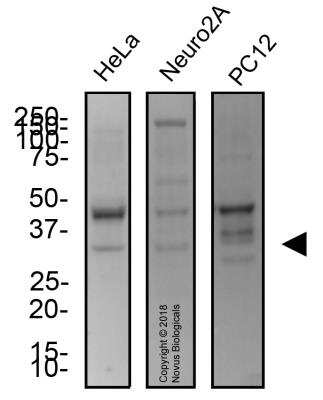UNG Rabbit Polyclonal Antibody
Frequently bought together (2)
Transient overexpression lysate of uracil-DNA glycosylase (UNG), transcript variant 2
USD 396.00
Other products for "UNG"
Specifications
| Product Data | |
| Applications | IHC, WB |
| Recommended Dilution | Immunohistochemistry, Immunocytochemistry/ Immunofluorescence: 1:10-1:500, Immunohistochemistry-Paraffin: 10 ug/ml, Western Blot: 2 ug/ml |
| Reactivities | Human, Mouse, Rat, Rabbit |
| Host | Rabbit |
| Clonality | Polyclonal |
| Immunogen | This antibody was generated by immunizing rabbit with a synthetic peptide sequence CRHFSKTNELLQKSGKKP corresponding to amino acids 281-298 of human UNG1 (NP 003353.1) and amino acids 290-307 of human UNG2 (NP 550433.1). The peptide sequence used for imm |
| Formulation | PBS containing 0.05% BSA, 0.05% Sodium Azide. Store at 4C short term. Aliquot and store at -20C long term. Avoid freeze-thaw cycles. |
| Concentration | lot specific |
| Purification | Protein G purified |
| Conjugation | Unconjugated |
| Storage | Store at -20°C as received. |
| Stability | Stable for 12 months from date of receipt. |
| Gene Name | uracil DNA glycosylase |
| Database Link | |
| Background | The human UNG gene encodes both nuclear (UNG2) and mitochondrial (UNG1) forms of uracil-DNA glycosylase. These forms are generated by alternative splicing and the use of two differentially regulated promoters, PA and PB (Slupphaug et al., 1993; Nilsen et al., 1997) The cDNAs for UNG1 and UNG2 are of similar size (2061 and 2058 bp, respectively) and as a result the corresponding mRNAs are not resolved as two species in gel electrophoresis (Huag et al., 1998). Nuclear UNG2 differs from mitochondrial UNG1 in 44 amino acids of the N-terminal sequence that is not necessary for catalytic activity. A major role of the UNG gene products is to repair mutagenic U:G mispairs caused by cytosine deamination. For example, UNG2 removes misincorporated dUMP residues. The level and expression pattern of UNG1 and UNG2 differs between cell and tissue type (Huag et al. 1998). Additionally, the expression of UNG is cell cycle regulated (Nagelhus et al. 1995). The expression and activity of UNG has been found in general to be higher in proliferating as compared to nonproliferating tissues and cells (reviewed in Kruman et al. 2004). UNG1 is a 304 amino acid protein. UNG2 is a 313 amino acid protein. |
| Synonyms | DGU; HIGM4; HIGM5; UDG; UNG1; UNG2; UNG15 |
| Note | Western Blot: Predicted molecular weight 36.5 kDa. Immunocytochemistry/Immunofluorescence See Yang et al (2005) |
| Reference Data | |
| Protein Families | Druggable Genome, Stem cell - Pluripotency |
| Protein Pathways | Base excision repair, Primary immunodeficiency |
Documents
| Product Manuals |
| FAQs |
| SDS |
{0} Product Review(s)
0 Product Review(s)
Submit review
Be the first one to submit a review
Product Citations
*Delivery time may vary from web posted schedule. Occasional delays may occur due to unforeseen
complexities in the preparation of your product. International customers may expect an additional 1-2 weeks
in shipping.






























































































































































































































































 Germany
Germany
 Japan
Japan
 United Kingdom
United Kingdom
 China
China




